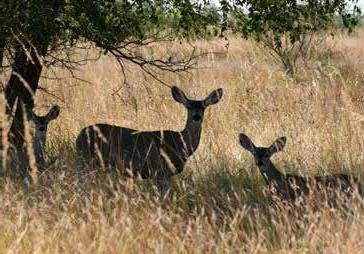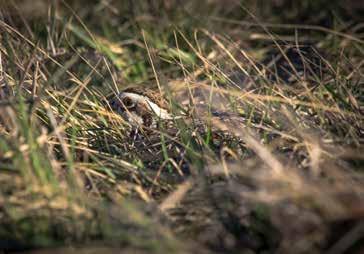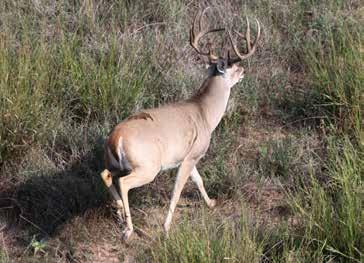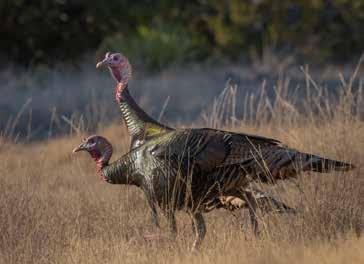
11 minute read
Grass
It’s More than Forage
Article by STEVE NELLE
Ask any cattleman what they first think when they see a pasture full of good grass. Most will get a big smile and think about how many cows it will feed and for
how long.
To the cattleman, grass is forage and forage is money. That is one valid way to look at the value of grass, but it is not the only way. Even the most cow-centric rancher knows there is a lot more to grass than just its value as feed, but forage is what gets them excited.
When thinking about grass there is plenty to get excited about, and we can all broaden our knowledge and appreciation of this important family of plants.
There are more than 700 species of grass in Texas with perhaps 200 species that are prevalent; a ranch in any given region is likely to have 30 to 60 grass species.
The different grass types, sometimes called functional groups, are just as important as the number of species. The functional groups include: cool season grasses, warm season grasses, bunch
grasses, colony-forming grasses, short grasses, mid grasses, tall grasses, annual grasses, perennial grasses, palatable grasses as well as unpalatable grasses.
Each group fulfills a certain purpose. It takes many of these types to have a healthy functioning grassland community.
GRASS ROOTS PROTECT SOIL
The most important part of the grass plant, perhaps, is underground. Because the root system is unseen, it is easy to overlook its significance and extent.
The root system makes up 60 to 80 percent of the perennial grass plant. Anyone who has dug up grass plants can appreciate the density and strength of roots and their ability to bind the soil. Mid grasses such as sideoats grama produce something like 4,000 feet of roots within one cubic foot of soil, while tall grasses produce twice or three times that amount.
About half of those roots die each year to be replaced by new roots. This annual turnover of roots is the main source of organic matter for grassland soils. This banking of organic carbon in the soil not only improves grassland condition, it also helps reduce atmospheric carbon.
The root crown is also important for storing energy. During times of active growth, excess plant energy stored as carbohydrates is directed to the plant's base and this energy is then used to initiate new growth after grazing, drought, fire or winter dormancy.
Think of the root system like the battery on your pickup in which energy is continually being used and then recharged. The more green leaf surface that is exposed to sunlight, the more energy is generated with which to grow deeper and stronger roots.
If grazing or mowing is excessive, stored energy is depleted and the root system becomes stunted. This leads to reduced soil and grass health.

WATER CONSERVATION
Grass also creates good water catching conditions so that rainfall soaks in rapidly and is stored in the soil. Depending on the underlying geology, some of this rainfall continues downward, making its way into aquifers.
A good, dense grass covering results in high organic matter, good soil structure, high soil porosity and high water-holding capacity. These qualities are markedly impaired where the grass cover is sparse or short.
In between grass plants there should be layers of old, residual decomposing grass litter that provides a blanket of protection to the soil surface. This litter layer, like mulch in a garden, should be nearly continuous. It helps protect from temperature extremes and reduces evaporation loss.

Photo by Steve Nelle
Healthy grasslands protect and enhance the soil and sustain the water cycle.
This landowner employed brush control, re-seeding and planned grazing to restore this grassland area.
Photo by Steve Nelle
GRASS SEED EATEN BY TURKEY, QUAIL OR DOVE
Bristlegrasses Paspalum grasses Fringed signalgrass Hall's panicum Browntop panicum Texas cupgrass Slim tridens White tridens Sideoats grama Johnsongrass Indiangrass
Good grass and litter cover also promotes good water quality. A good grass cover physically slows down the water as it moves downhill so that it cannot erode soil material. As a result, runoff remains clear-ish rather than muddy and sediment-laden. A paucity of grass results in more runoff, more erosion and poor water quality.
There is no way to drought-proof a ranch, but Dr. E. J. Dyksterhuis, a prominent range ecologist of the previous century, states the truth as plainly as anyone: “A man whose pastures are short needs rain the most. A man whose pastures are in good shape makes the most of the rain he gets.”
In creek and river bottom areas strong grasses are especially important. Riparian grasses tend to have much stronger and denser roots than upland grasses. These massive root systems are needed to dissipate and withstand the erosive energy of floodwaters.
WILDLIFE FOOD
Many species of wildlife consume the leaves and/or the seed of grasses. A prime example is turkeys, which graze the leaves and eat the seed of many grass species. Dove and quail often consume the hard seed of panicum, paspalum and bristlegrass.
Small songbirds, such as sparrows and buntings consume many different kinds of grass seed, even the tiny fluffy seed of bluestems. Most kinds of rodents eat grass seed, and these in turn are what sustain strong raptor and snake populations.
Mule deer, white-tail and pronghorn may only consume grass for five or 10 percent of their diet but this still amounts to about 75 to 150 pounds of grass eaten each year. During certain seasons, grass may make up a much higher percentage.
Grassy areas also help produce insects which are vital for many bird species. So directly or indirectly a high proportion of wildlife species benefit from or depend upon grasses for their food supply.
NESTING AND FAWNING COVER
If it were not for the protection afforded by grasses, many species of wildlife would be ravaged by predators. For ground nesting game birds, songbirds, big game and small mammals, their reproductive success depends on staying well hidden in grass until the young are able to evade predators. Ranchers, having a shared interest in wildlife habitat, adjust the timing and intensity of grazing to accommodate the amount of grass needed for nesting and fawning.
Photo by Rita Frey Photo by Steve Nelle

Photo by Rita Frey Photo by Rita Frey



Although predators will always get their fair share of nests and fawns no matter how much grass there is, an appropriate cover of bunch grass is the best way to insure adequate production of young. For quail, about 300 large, lightly grazed grass clumps per acre is needed for good nesting habitat.
PRESCRIBED BURNING
The merits of prescribed burning have been well-recognized for many years, and the acceptance of fire is increasing. One of the important secondary benefits of grass is to serve as fuel for prescribed burns; without an adequate grass cover, successful burning is not possible. Anyone who has tried to burn a pasture with inadequate grass knows how futile, frustrating and ineffective it is.
When burning is done wisely, it can be one of the more useful and cost-effective tools, and it is totally dependent on having a good grass cover. Ranches that employ prescribed burning have a systematic approach whereby one or more pastures remain ungrazed, often for a year or two to grow an adequate amount of grass for fuel.
All practices come with a degree of risk, and it is important to understand the risks of prescribed burning and not to view it as a panacea. Like any other practice it has potential benefits and rewards as well as costs and risks.
FORAGE
Even though there are other important functions of grass, livestock forage is one of its major purposes. Cattle consume about 3 percent of their body weight each day, so a 1,300-pound cow is eating almost 40 pounds a day (dry weight basis) or in excess of 14,000 pounds annually.
An immense volume of grass is needed to sustain livestock production. Grass must be intentionally and carefully managed to ensure that you don’t run out.
Not all grass species provide equal forage value—some is highly preferred; some is shunned, and some is eaten as second or third choice when better grasses are unavailable. This pattern of selective grazing can lead to grassland degradation as the favored species are grazed short and the lesser species remain ungrazed.
Over time and without frequent rest periods grasslands will decline in condition even if they are properly stocked. Giving the better grasses a chance to recover and regrow following grazing is the primary reason carefully monitored, rotational grazing is needed.
Photo by Rita Frey Photo by Rita Frey

Photo by Rita Frey Photo by Steve Nelle




Photo by Steve Nelle
Robust riparian grasses hold creek bottom areas together during flood events and provide grazing and habitat.
Even arid regions like the Trans Pecos can support healthy grasslands with proper management.
Photo by Steve Nelle

MANAGING GRASS
Progressive ranchers understand that they are really grass farmers and that livestock is the way that the grass is harvested and put to good use. Those who live by that ideal understand how grass grows, and they take pains to keep pastures healthy.
They know that grass production constantly fluctuates and that livestock numbers must be periodically adjusted to avoid overgrazing. Keeping the grass ahead of the cattle is a key priority, and overgrazing is a cardinal sin.
The old rule of thumb for proper grazing used to be “take half / leave half,” but this has proven to be misleading, and a strict following of this will usually result in overgrazing. The new concept, advocated by nearly all range management specialists is to allocate about 25 percent of the total forage supply for livestock consumption.
This 25 percent is called the harvest efficiency, and it recognizes that there is a large amount of grass that disappears or is unaccounted for. Much grass is consumed by insects, rodents and rabbits, or it is trampled and wasted making it unavailable as livestock forage. By grazing only about one quarter of the total grass, the manager can be assured that plenty will be left ungrazed for grass health, soil health, habitat and other purposes.
GRASSLAND REHABILITATION
Rangeland that has been badly damaged by extreme drought, harsh wildfire, prolonged overgrazing or a combination of these needs rehabilitation. One of nature's marvels is damaged land's self-healing tendency.
Within each region there are pioneer grasses whose primary function is
SOME CHARACTERISTIC NATIVE GRASSES OF EACH REGION
South Texas Trans Pecos Panhandle East Texas Central Texas Gulf Coast
Pink pappusgrass Black grama Blue grama Broomsedge bluestem Sideoats grama Gulf cordgrass Plains bristlegrass Blue grama Buffalograss Splitbeard bluestem Little bluestem Longtom
Trichloris Bush muhly Hooded windmillgrass Narrowleaf woodoats Texas wintergrass Gulf muhly
Slender grama Bull muhly Western wheatgrass Brownseed paspalum Curlymesquite Indiangrass
Tanglehead Burrograss Sand dropseed Giant cane Silver bluestem Big bluestem Arizona cottontop Cane bluestem Sand lovegrass Wildrye Meadow dropseed Smutgrass
Photo by Steve Nelle
establishing and growing on bare ground and depleted soils. These are not the prime grasses for forage or habitat, but they can grow where other grasses cannot. As these colonizing grasses grow and increase, they gradually improve soil conditions so that other higher value grasses can begin to grow.
Severely damaged ranges have to go through a natural process called succession to eventually grow better and better grasses. It takes time and skillful management. Often, brush control is first needed to help shift the balance toward grass.

PIONEER GRASSES FOR NATURAL REHABILITATION


Hall's panicum Reverchon bristlegrass Broomsedge bluestem Poverty dropseed Texas wintergrass Sandbur Showy chloris Crabgrass Red lovegrass Tumblegrass Tumble lovegrass Little barley Green sprangletop Common witchgrass Carolina canarygrass
Landowners can accelerate this rehabilitation process by re-seeding with native species, which has proven to be a good way to restore degraded ranges in many places. Re-seeding does not have to be overly expensive, but it can be depending on the mix of species chosen.

HOLISTIC STEWARDSHIP
When considering the value and management of grass, we do well to put on wide angle viewing glasses and see it from many complementary angles. If we just see nest cover, or forage or fuel for a burn, we are guilty of tunnel vision and will end up with an unbalanced view and unbalanced management.
Astute ranchers understands that they are managing not only forage for livestock but also wildlife habitat, soil health, water quality, the water cycle, carbon cycle, biodiversity and economic sustainability. The only way that all of these things can be properly managed is when the land is viewed holistically through the lens of stewardship. Holistic stewardship realizes the many varied aspects of land management and endeavors to balance the ecological, economic and social values that are a part of owning and managing land.





